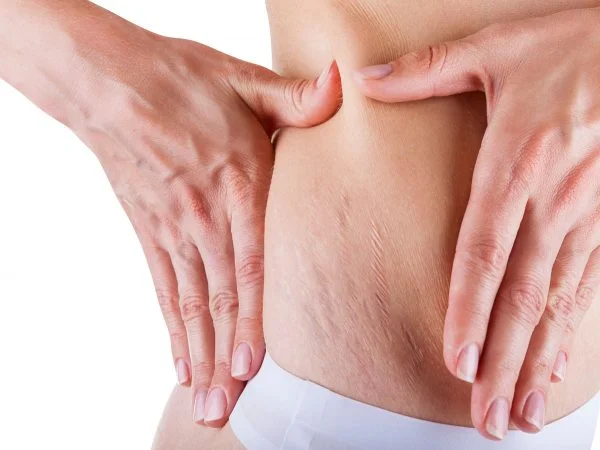The Truth About Stretch Marks

Got stretch marks? Welcome to the human race! Stretch marks affect a great number of men and women of all ages, sizes, and ethnicities. Despite their prevalence, most of us know relatively little about what causes these depressed, linear skin markings, much less how to treat stretch marks we would rather not have.
Unfortunately, misunderstandings about stretch marks continue to circulate, from the myth that they are only a “women’s problem,” to the idea that weight loss can get rid of them. Here are a few facts about stretch marks that will help you sort out the science from the fiction.
What exactly are stretch marks, and why do people get them?
Overall, our skin does an amazing job keeping up as our bodies grow and change. Thanks to collagen and elastin, those hallmarks of firm, youthful skin, our skin has an elastic quality that allows it to expand and contract in response to moderate fluctuations in shape and size. During periods of rapid growth, however, the inner layer of skin called the “dermis” may not be able to produce collagen and elastin quickly enough to keep up, resulting in small tears. The tears eventually heal into the linear, indented scars that we know as stretch marks, or “striae,” as they are known in the medical community.
Additionally, certain lifestyle habits, such as smoking and excessive sun exposure, damage your skin’s elasticity, increasing the likelihood of developing stretch marks with weight fluctuation or growth.
We tend to associate stretch marks with weight gain and pregnancy, but men, teenagers and even bodybuilders—anyone undergoing a period of rapid growth—can get stretch marks.
Stretch marks are functionally harmless and can appear anywhere on the body, but occur most frequently on the trunk, arms, legs, flanks and breasts. Now, let’s separate myths about stretch marks from reality.
Myth: Stretch marks are mainly caused by gaining weight quickly.
Truth: We tend to associate stretch marks with rapid weight gain, whether from overeating or pregnancy. In fact, any individual undergoing a period of rapid growth, including slender teenagers and bodybuilders, are more susceptible to stretch marks.
Natural hormonal shifts, as well as certain medications (i.e., corticosteroids), can reduce the rate of collagen and elastin production, making a person more prone to stretch marks. Genetics also play a significant role; which is why some people never get stretch marks, while others develop stretch marks at a young age.
Myth: Stretch marks are only an issue for women.
Truth: With naturally thinner skin and more hormonal shifts throughout the life cycle, women are more likely to get stretch marks and are particularly vulnerable to them during pregnancy. However, men are not immune to stretch marks. Males frequently get stretch marks during puberty, as well as after gaining significant weight or rapidly increasing muscle mass.
Myth: You can prevent stretch marks by using special creams.
Truth: While good skincare habits, including sunscreen use and moisturizing, can help preserve skin elasticity and a youthful appearance, there is no way to prevent stretch marks from forming if you are genetically prone to them.
There is no way to prevent stretch marks if you are genetically prone to them, but skin resurfacing treatments, including microneedling or lasers, can help them fade significantly.
Newly formed stretch marks can sometimes respond well to topical skin medications containing tretinoin (i.e., Retinol) or peptides, which help boost collagen production and cell turnover, but even these will just lessen their appearance. Exfoliation, massage, and essential oils are also touted as stretch mark treatments, but, at best, these methods only temporarily reduce their appearance, and none are effective ways to prevent stretch marks.
Myth: Losing weight will help you get rid of stretch marks.
Truth: Stretch marks are essentially scars, and weight loss has no more of an effect on them as it does on any other visible scarring. Even if your skin contracts well to your slimmer contours after losing weight, stretch marks will still be visible.
The only way to completely remove stretch marks is to surgically remove the affected area of skin; that is one benefit of tummy tuck surgery for many patients. For those patients who do not need or want to undergo surgery, there are a few effective treatments to help stretch marks fade significantly, though not completely. For example, we’ve been seeing excellent results with microneedling, a resurfacing treatment that works by triggering natural skin regeneration and collagen remodeling. Because it is heat- and chemical-free, microneedling is safe for any skin type and can be used nearly anywhere on the body. Laser treatments can also be a good option for some select patients.
All in all, stretch marks are perfectly normal part and nothing to be ashamed of. That said, if you are bothered by the way they look, there is no reason to put up with stretch marks forever. If you are in the Fort Worth area, I encourage you to contact us for a consultation. Our expert skin care team will be glad to answer your questions and help you learn about safe, effective options to reduce the appearance of stretch marks and enjoy smoother, firmer skin.



Can I use coconut oil to cure my stretch marks
While coconut oil can help moisturize the skin and may slightly improve the appearance of stretch marks, it doesn’t completely eliminate them. For more effective treatments, it’s best to consult with a qualified provider such as a board-certified plastic surgeon or an aesthetician at a physician-led medical spa.